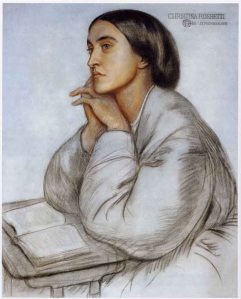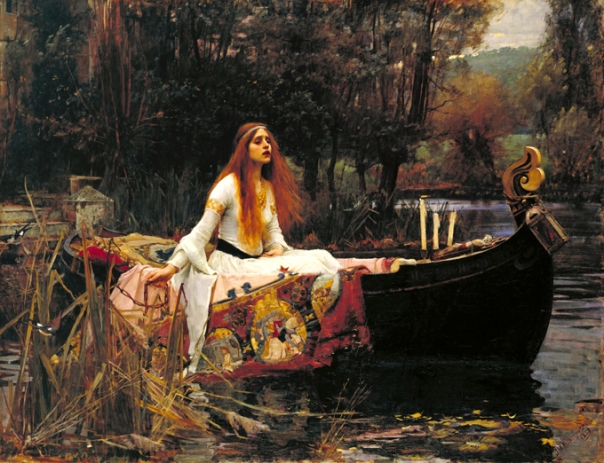
Drama at Dusk

Dante Gabriel Rossetti’s Sister, Christina Georgina Rossetti.
Dante Gabriel Rossetti
Dante Gabriel Rossetti (12 May 1828 – 9 April 1882) was an English poet, illustrator, painter and translator who founded the ‘The Pre-Raphaelite Brotherhood’. Rossetti’s art was characterised by its sensuality and its medieval revivalism and his personal life was closely linked to his work, especially his relationship with his model, muse, and eventually his wife, Elizabeth Siddal (Lizzie).
The first Piece is a chalk portrait sketch of Dante Gabriel Rossetti’s sister, Christina Georgina Rossetti; herself an acclaimed poet. Christina wrote a variety of romantic, devotional and children’s poems – best remembered for her long poem, ‘Goblin Market’, her love poem ‘Remember’ and the words to the Christmas carol ‘In the Bleak Mid-Winter’.
The second piece, ‘Beata Beatrix’, is arguably one of Rossetti’s finest paintings and undoubtedly the most emotionally moving piece due to the tragic events surrounding its dedication. Depicting Beatrice Portinari from Dante Alighieri’s poem ‘La Vita Nuova’ at the moment of her death, Rossetti modeled the subject after his deceased wife Elisabeth Siddal (original spelling ‘Siddall’).
It’s very interesting how Rossetti portrays the different emotions relating to the two works of art; how he distinguishes the mood and emotion relating, not just to the circumstances that led to their production, but to his relation to the two female characters. In the chalk sketch of his sister Christina, he portrays his brotherly love for his beautiful sister – “This is my little sister – I’m very proud of her – she is very beautiful – she’s a brilliant poet – and we look after each other!” The picture perfectly depicts the care, the love and the emotion a brother feels for a sister; whereas the painting of Elisabeth Siddal (Lizzie), his deceased wife, not only portrays the grief (and guilt) relating to her tragic death, but perfectly embodies the love, adoration and passion a husband feels for his wife. The story of their life and love will be further discussed in later posts.

Drama at Dusk
Alfred Lord Tennyson’s Poem
The Lady of Shalott
John William Waterhouse’s painting – ‘The Lady of Shalott’ – from the previous post – was a result of inspiration from the poem by Alfred, Lord Tennyson by the same name and is a representation of a powerfully emotional scene from the story told in that poem. In the poem, Tennyson creates a literary masterpiece loosely based on the story of ‘Elaine of Astolat’, a tragic character from Thomas Malory’s ‘Le Morte d’Arthur’ who dies as a result of a ‘curse’ and her unrequited love for Sir Lancelot.
The free encyclopedia Wikipedia sums up the story better than I can:-
“According to legend, the Lady of Shalott was forbidden to look directly at reality or the outside world; instead she was doomed to view the world through a mirror, and weave what she saw into tapestry. Her despair was heightened when she saw loving couples entwined in the far distance, and she spent her days and nights aching for a return to normality. One day the Lady saw Sir Lancelot passing on his way in the reflection of the mirror, and dared to look out at Camelot – bringing about a curse. The lady escaped by boat during an autumn storm, inscribing ‘The Lady of Shalott’ on the prow. As she sailed towards Camelot and certain death, she sang a lament. Her frozen body was found shortly afterwards by the knights and ladies of Camelot, one of whom is Lancelot, who prayed to God to have mercy on her soul. The tapestry she wove during her imprisonment was found draped over the side of the boat.”
On either side the river lie Long fields of barley and of rye, That clothe the wold and meet the sky; And thro' the field the road runs by To many-tower'd Camelot; And up and down the people go, Gazing where the lilies blow Round an island there below, The island of Shalott. Willows whiten, aspens quiver, Little breezes dusk and shiver Thro' the wave that runs for ever By the island in the river Flowing down to Camelot. Four gray walls, and four gray towers, Overlook a space of flowers, And the silent isle imbowers The Lady of Shalott. By the margin, willow-veil'd Slide the heavy barges trail'd By slow horses; and unhail'd The shallop flitteth silken-sail'd Skimming down to Camelot: But who hath seen her wave her hand? Or at the casement seen her stand? Or is she known in all the land, The Lady of Shalott? Only reapers, reaping early In among the bearded barley, Hear a song that echoes cheerly From the river winding clearly, Down to tower'd Camelot: And by the moon the reaper weary, Piling sheaves in uplands airy, Listening, whispers "'Tis the fairy Lady of Shalott." Part II. There she weaves by night and day A magic web with colours gay. She has heard a whisper say, A curse is on her if she stay To look down to Camelot. She knows not what the curse may be, And so she weaveth steadily, And little other care hath she, The Lady of Shalott. And moving thro' a mirror clear That hangs before her all the year, Shadows of the world appear. There she sees the highway near Winding down to Camelot: There the river eddy whirls, And there the surly village-churls, And the red cloaks of market girls, Pass onward from Shalott. Sometimes a troop of damsels glad, An abbot on an ambling pad, Sometimes a curly shepherd-lad, Or long-hair'd page in crimson clad, Goes by to tower'd Camelot; And sometimes thro' the mirror blue The knights come riding two and two: She hath no loyal knight and true, The Lady of Shalott. But in her web she still delights To weave the mirror's magic sights, For often thro' the silent nights A funeral, with plumes and lights And music, went to Camelot: Or when the moon was overhead, Came two young lovers lately wed; "I am half-sick of shadows," said The Lady of Shalott. Part III. A bow-shot from her bower-eaves, He rode between the barley-sheaves, The sun came dazzling thro' the leaves, And flamed upon the brazen greaves Of bold Sir Lancelot. A redcross knight for ever kneel'd To a lady in his shield, That sparkled on the yellow field, Beside remote Shalott. The gemmy bridle glitter'd free, Like to some branch of stars we see Hung in the golden Galaxy. The bridle-bells rang merrily As he rode down to Camelot: And from his blazon'd baldric slung A mighty silver bugle hung, And as he rode his armour rung, Beside remote Shalott. All in the blue unclouded weather Thick-jewell'd shone the saddle-leather, The helmet and the helmet-feather Burn'd like one burning flame together, As he rode down to Camelot. As often thro' the purple night, Below the starry clusters bright, Some bearded meteor, trailing light, Moves over still Shalott. His broad clear brow in sunlight glow'd; On burnish'd hooves his war-horse trode; From underneath his helmet flow'd His coal-black curls as on he rode, As he rode down to Camelot. From the bank and from the river He flash'd into the crystal mirror, "Tirra lirra," by the river Sang Sir Lancelot. She left the web, she left the loom, She made three paces thro' the room, She saw the water-lily bloom, She saw the helmet and the plume, She look'd down to Camelot. Out flew the web and floated wide; The mirror crack'd from side to side; "The curse is come upon me," cried The Lady of Shalott. Part IV. In the stormy east-wind straining, The pale-yellow woods were waning, The broad stream in his banks complaining, Heavily the low sky raining Over tower'd Camelot; Down she came and found a boat Beneath a willow left afloat, And round about the prow she wrote The Lady of Shalott. And down the river's dim expanse-- Like some bold seër in a trance, Seeing all his own mischance-- With a glassy countenance Did she look to Camelot. And at the closing of the day She loosed the chain, and down she lay; The broad stream bore her far away, The Lady of Shalott. Lying, robed in snowy white That loosely flew to left and right-- The leaves upon her falling light-- Thro' the noises of the night She floated down to Camelot: And as the boat-head wound along The willowy hills and fields among, They heard her singing her last song, The Lady of Shalott. Heard a carol, mournful, holy, Chanted loudly, chanted lowly, Till her blood was frozen slowly, And her eyes were darken'd wholly, Turn'd to tower'd Camelot; For ere she reach'd upon the tide The first house by the water-side, Singing in her song she died, The Lady of Shalott. Under tower and balcony, By garden-wall and gallery, A gleaming shape she floated by, A corse between the houses high, Silent into Camelot. Out upon the wharfs they came, Knight and burgher, lord and dame, And round the prow they read her name, The Lady of Shalott. Who is this? and what is here? And in the lighted palace near Died the sound of royal cheer; And they cross'd themselves for fear, All the knights at Camelot: But Lancelot mused a little space; He said, "She has a lovely face; God in his mercy lend her grace, The Lady of Shalott." The painting and the poem, together, exponentially illustrate the 'Power and the Emotion' of 18th and early 19th century Fine Art!

Is there a more powerful image than Waterhouse’s ‘The Lady of Shalott’?
Alongside Tennyson’s poem, you’ve got ‘Art and Heart’ – ‘Power and Emotion’!